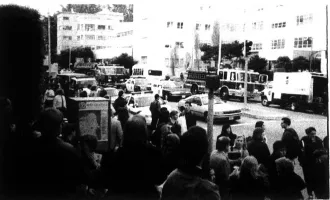Nighttime Orthodontic Clinic Opens at the Dental School
A new evening dental clinic at UCSF is offering orthodontic care to low-income patients at nearly one-tenth of the typical cost.
The UCSF Orthodontic Night Clinic, which was launched at the UCSF Dental School this month, will be held once a month. The first night was already busy, as orthodontic residents and dental students attended to the steady stream of new patients, most of whom were getting pre-treatment impressions and photographs
“I thought it was a really great learning experience,” said Abraham Tang, a third-year dental student and one of the volunteers. “Also, it gives students who are interested in orthodontics a chance to learn more about the field.”
Rather than using braces to move teeth, this community orthodontic model instead uses all-removable devices, primarily retainers, with springs and wires that exert force on the teeth.
This approach is a simple and efficient way to correct many serious orthodontic problems and has one notable advantage: It does not require that an orthodontist be available full-time for emergency adjustments.
“The goal is not for aesthetic purposes,” said Dr. James Chen, who started the clinic. “The primary goal is to help in functional improvements for the patients who most need it.”
Patients might have, for example, either badly aligned teeth or a bite that prevents proper functioning of the teeth, whether when eating or speaking. In more extreme causes, abnormal dentition can be a constant source of trauma to soft tissue, can aggravate the temporomandibular joint (TMJ) or cause the teeth to be ground away rapidly.
The patients are recruited through the San Francisco Dental Public Health Group and during screening days around The City. For example, when the School of Dentistry held its annual Give Kids a Smile Day recently, people who had serious orthodontic needs were informed of the new clinic.
Some patients are from families that cannot afford treatment at the regular UCSF daytime orthodontic clinic. Another large group of patients have teeth that are basically functional but cosmetically unusual enough to cause social embarassment.
The typical treatment requires one to four different removable appliances to be made for each patient and takes at most a year and a half to complete. Some cases, however, can be treated in just a few months. “Eventually, at each monthly clinic night, I want to have a three-hour schedule with six new consults, six new starts and 15 to 20 adjustments,” said the indefatigable Dr. Chen.
Dr. Chen, who received his DDS and PhD at UCSF in 2005 and 2011 respectively, has made the efficacy of community orthodontics the focus of his research as a new UCSF faculty member. He is modeling his clinic on a similar program at La Clinica de La Raza in Oakland. UCSF orthodontic residents do regular rotations there, and Dr. Chen still volunteers there himself, as part of his research. The La Clinica community orthodontic program was started in the early 1980s, when public-minded dentists noticed an unmet need for orthodontics among its patient population. The program’s first chair was donated by the UCSF School of Dentistry.
One change Dr. Chen envisions for the UCSF clinic is to teach dental students the basics of case selection and appliance design, so that they can help provide the care alongside more experienced orthodontic residents. The night clinic therefore not only benefits patients, but also enhances students’ knowledge and skills.
“I really want to make orthodontics a bigger part of the education for dental students here at UCSF,” said Dr. Chen. “Ideally, I’d like to set up each dental student with a patient whom they would follow to the completion of treatment.”
In modern America, having straight teeth and a nice bite confers a certain class status. By increasing access to orthodontic care, the UCSF night-time clinic provides a service that only the wealthy can typically afford. In this respect, the new clinic is not just providing access to health care, but access to greater opportunity.


